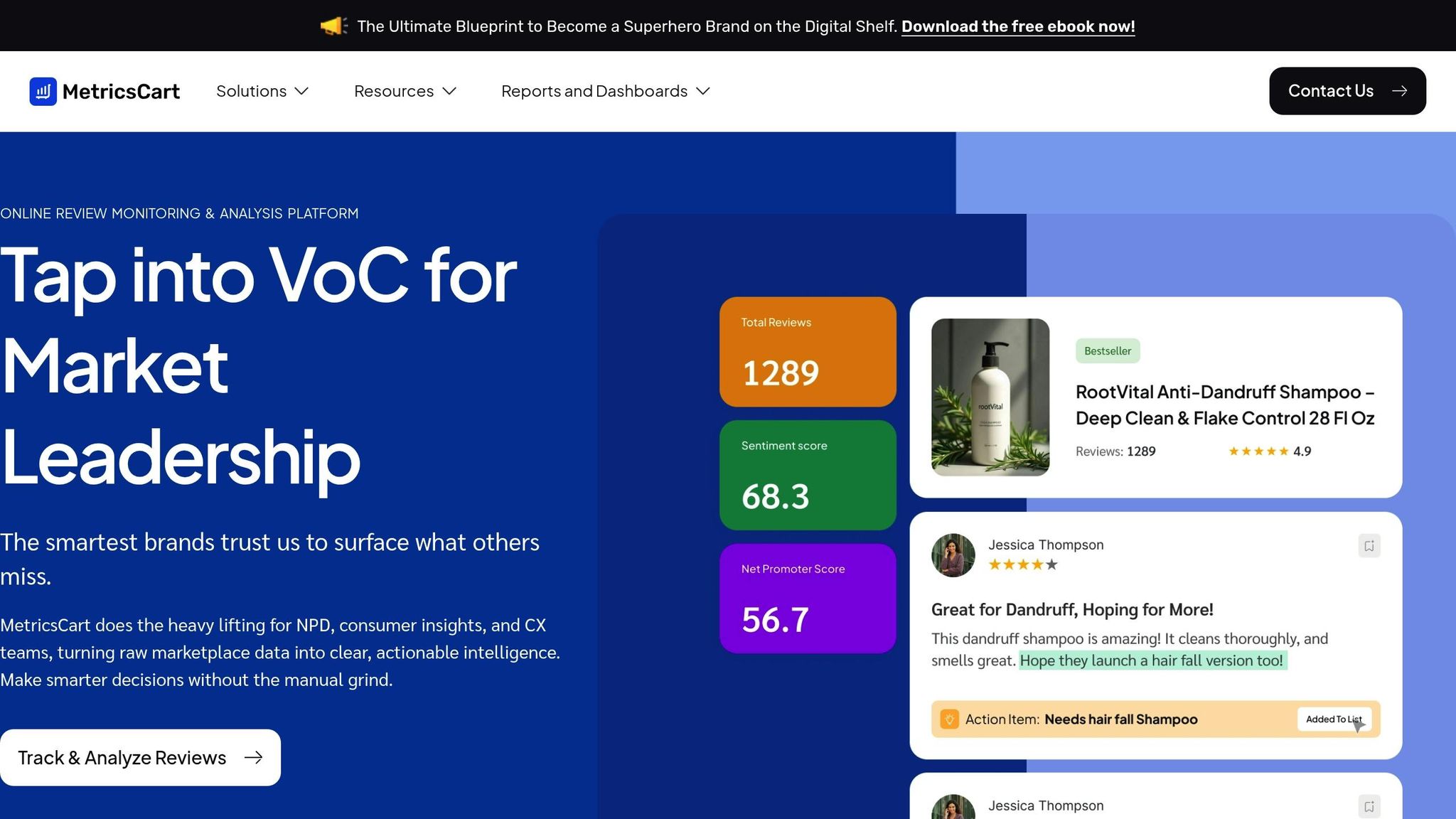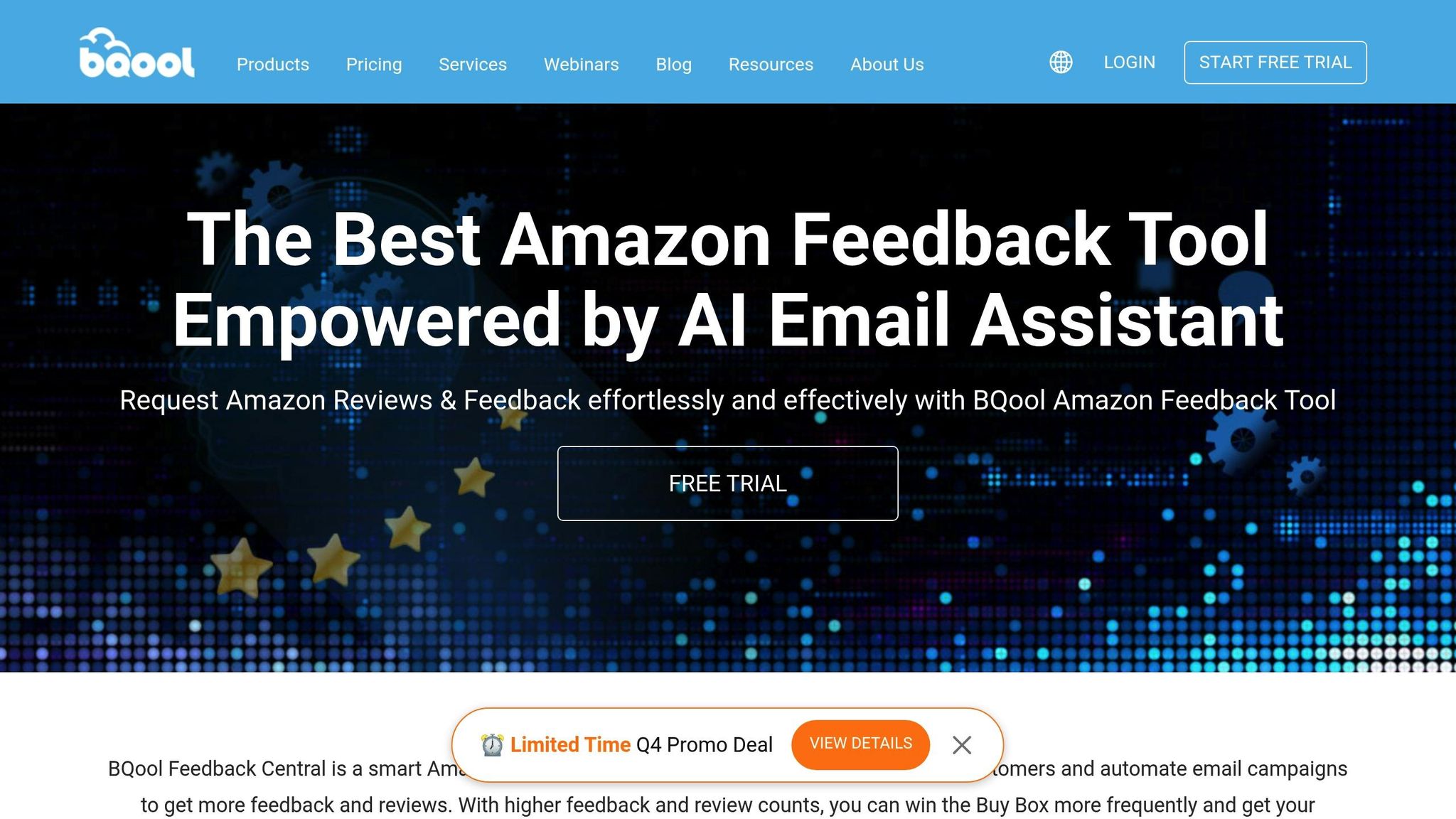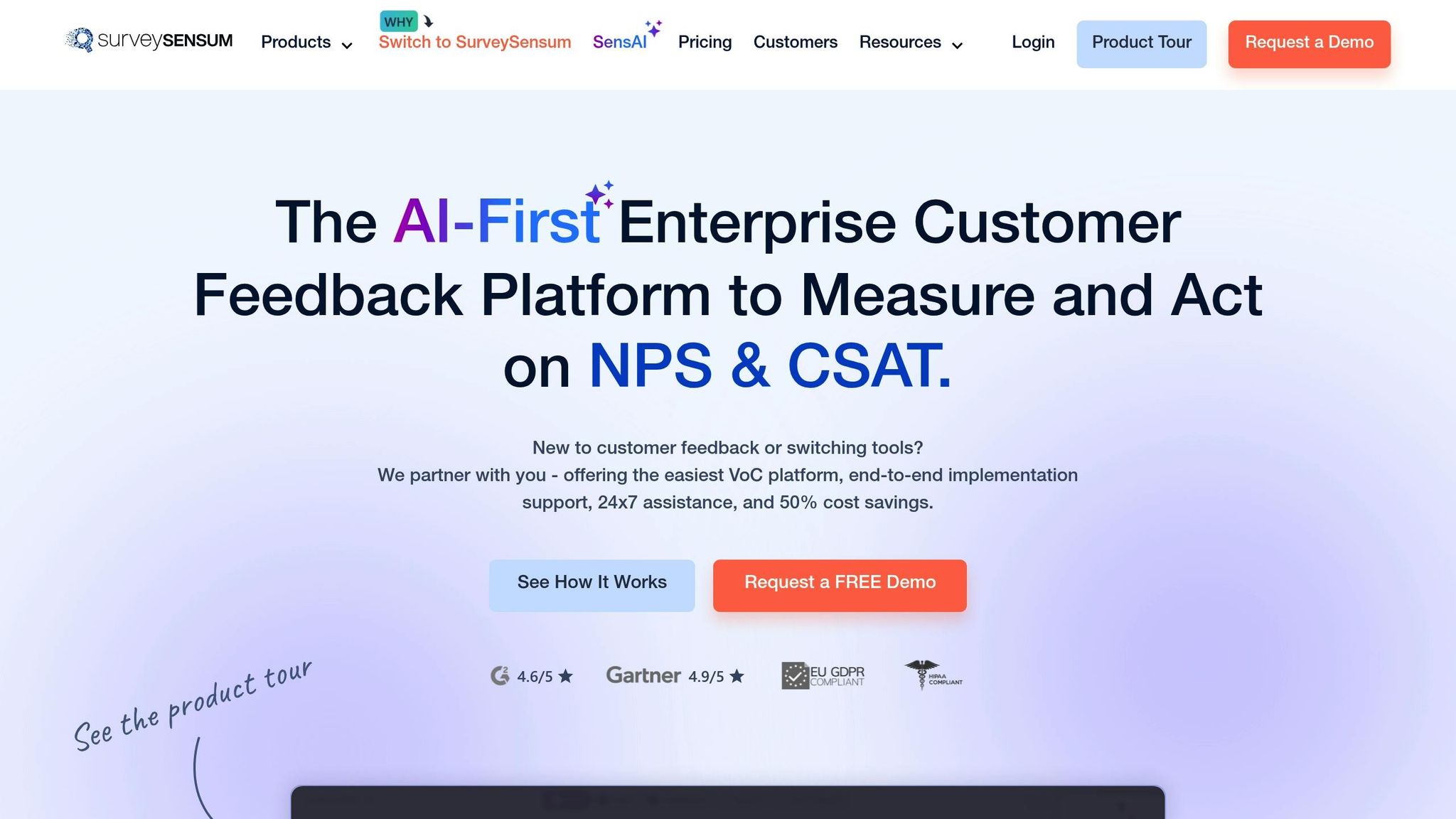Analyzing Amazon customer feedback can be overwhelming, but using the right tools simplifies the process and helps sellers improve their products, listings, and customer satisfaction. Here’s a quick overview of the best tools available:
- MetricsCart: AI-powered, categorizes feedback by themes like "shipping delays" or "packaging issues", and tracks sentiment across platforms.
- FeedbackFive: Automates review requests, sends alerts for negative reviews, and complies with Amazon policies. Starts at $24/month.
- BQool Feedback Central: Affordable ($10/month), great for multi-account management and sentiment analysis.
- SurveySensum: Offers detailed sentiment scoring and real-time alerts for trends.
- FlatFilePro: Combines feedback analysis with listing management. Plans start at $99/month, ideal for sellers with large catalogs.
Key Takeaway: These tools save time, identify trends, and enable sellers to address customer concerns effectively. Choose a tool based on your budget, catalog size, and business needs.
How To Use This AI Tool to Analyze Amazon Reviews and Improve Your Products
Top Customer Feedback Analysis Tools
To effectively monitor and respond to customer sentiment, these tools transform reviews into actionable insights. Each platform brings unique strengths to the table, catering to different business needs.
MetricsCart
MetricsCart uses AI to analyze reviews in real time, categorizing customer feedback into specific issues like "shipping delays" or "color mismatch." It tracks reviews across multiple channels, giving sellers a complete view of customer sentiment and allowing them to quickly spot trends.
This platform is ideal for mid-to-large sellers who rely on detailed analytics to guide product and operational improvements. With its cross-platform tracking, MetricsCart provides a unified perspective on the customer experience.
FeedbackFive
FeedbackFive simplifies review management by automating requests while adhering to Amazon’s policies. Sellers can create personalized email campaigns and receive detailed analytics, including instant alerts for negative reviews.
An electronics brand leveraged FeedbackFive to automate review requests for tens of thousands of orders, streamlining feedback collection and improving overall ratings [1]. While its features cater to high-volume operations, some users feel the interface could use a modern refresh. Plans start at $24/month after a free trial, and the platform offers customizable email templates and analytics to help maintain a positive reputation [3].
BQool Feedback Central
For sellers seeking affordability and multi-account management, BQool Feedback Central delivers AI-driven features starting at just $10/month. It offers customizable email templates, real-time monitoring, and sentiment analysis, enabling sellers to address customer concerns before they escalate.
This tool is particularly popular among aggregators managing multiple Amazon stores, thanks to its efficiency in handling review requests. Though its reporting capabilities are less robust than premium platforms, its cost-effectiveness makes it a great choice for budget-conscious sellers or those new to automated feedback management [1].
SurveySensum
SurveySensum provides advanced feedback analysis with aspect-level sentiment scoring, achieving up to 99% accuracy. Its AI assigns sentiment scores to specific product aspects like design, usability, or delivery, offering sellers granular insights into customer opinions.
The platform consolidates Amazon reviews into a single dashboard and sends real-time alerts when sentiment trends downward. Features like automated theme tagging and visual dashboards help teams quickly identify recurring issues. SurveySensum’s SensAI assistant allows sellers to ask targeted questions – such as identifying the root causes of negative sentiment – and receive instant, data-driven summaries [2].
FlatFilePro
FlatFilePro combines feedback analysis with listing management. Its Reflection Engine automatically monitors listings nightly, flagging discrepancies that might lead to negative reviews.
"This is the tool that powers our ops and analytics teams. We used to do everything manually, such a pain! Now we don’t have to think about anything, and our listings update like magic!" – Jack Haldrup, Founder, Dr. Squatch [4]
FlatFilePro categorizes listing problems (e.g., Product Identity, Details, Shipping, Safety) and tracks changes through activity logs. This helps sellers connect listing updates to shifts in review sentiment, improving overall performance. The platform also supports international marketplaces, ensuring consistent product information across regions – a key factor in avoiding negative feedback from conflicting details. After a free trial, plans start at $99/month for two marketplaces, with additional regions available for $29/month each, and it includes a six-month ROI guarantee.
Tool Feature Comparison
When it comes to selecting the right feedback analysis tool, your choice will hinge on factors like your budget, business size, and specific needs. Pricing varies significantly depending on the features and the size of your catalog.
Pricing and Value Proposition
For those just starting or operating on a tight budget, BQool Feedback Central offers an affordable entry point at $10/month. It’s a great option for new sellers or those looking to keep costs low. FeedbackFive, priced at $24/month after a free trial, positions itself as a more premium option, catering to established sellers managing higher volumes. On the higher end, FlatFilePro starts at $99/month for two marketplaces, with extra regions costing $29/month each. It also includes a six-month ROI guarantee, making it a safer choice for sellers with larger catalogs.
For advanced tools like MetricsCart and SurveySensum, pricing is available upon request, which typically signals enterprise-level costs. These tools justify their higher price tags with AI-driven features and comprehensive analytics capabilities.
Core Functionality Differences
Although these tools share common feedback management features, each has unique strengths tailored to different needs:
- MetricsCart shines in real-time thematic categorization, using AI to pinpoint issues like "fragile packaging" or "shipping delays." For example, a beauty brand reduced its return rates by 12% after addressing packaging complaints identified through MetricsCart insights [1].
- SurveySensum specializes in aspect-level sentiment analysis, breaking down customer feedback into granular elements like design, usability, and delivery. Its sentiment analysis achieves up to 99% accuracy, making it ideal for detailed product evaluations [2].
- FeedbackFive focuses on automation and compliance, streamlining review requests while ensuring adherence to Amazon’s policies.
- BQool stands out with multi-account management and AI-powered scheduling, making it particularly useful for aggregators managing multiple Amazon stores.
- FlatFilePro offers a mix of feedback analysis and listing management. Its Reflection Engine flags nightly listing discrepancies that could lead to negative reviews. With bulk editing capabilities and a 95% success rate for variation updates, it’s designed to ensure listing accuracy and reduce customer complaints.
| Tool | Monthly Cost | Free Trial | Key Strength | Best For |
|---|---|---|---|---|
| BQool Feedback Central | $10+ | Not specified | Multi-account management, affordability | Budget-conscious sellers, aggregators |
| FeedbackFive | $24+ | Yes | Automation, compliance, established reputation | Large sellers, high-volume operations |
| FlatFilePro | $99+ | Yes (7 days) | Listing accuracy and bulk management | Sellers with 100+ listings, agencies |
| MetricsCart | Contact for pricing | Not specified | AI thematic analysis, cross-platform monitoring | Mid-to-large sellers needing deep insights |
| SurveySensum | Contact for pricing | Not specified | Advanced sentiment analysis, centralized dashboards | Enterprise teams, multi-channel analysis |
Integration and Scalability
All these tools integrate seamlessly with Amazon Seller Central, but their scalability varies. FeedbackFive and MetricsCart support multiple Amazon marketplaces, making them suitable for sellers operating internationally. SurveySensum goes a step further by unifying feedback from Amazon and other channels into centralized dashboards [2]. FlatFilePro, on the other hand, simplifies listing management across all Amazon marketplaces through a single account. Its API syncs data multiple times a day, ensuring real-time accuracy and consistency across regions.
ROI Considerations
The return on investment depends heavily on your catalog size and operational needs. For smaller sellers, BQool’s $10/month plan offers excellent value with basic automation and multi-store management. Mid-sized sellers might find FeedbackFive’s $24/month plan worthwhile for its ability to boost review collection and manage reputation effectively. For those with expansive catalogs, FlatFilePro’s $99/month pricing is justified by the time saved through bulk operations and automated listing management.
For larger enterprises, MetricsCart and SurveySensum justify their higher costs by offering advanced analytics that empower data-driven decisions and product improvements. These tools are ideal for businesses looking to refine their strategies through deeper customer insights.
sbb-itb-ed4fa17
Best Practices for Feedback Analysis
To make the most of today’s advanced tools, follow these best practices to turn customer feedback into meaningful improvements for your listings. By focusing on actionable insights, you can transform reviews into a roadmap for success.
Centralize All Your Feedback Sources
One major pitfall is analyzing feedback in isolation. Customers share their opinions across various platforms – Amazon reviews, email support, social media, and direct messages. By consolidating all feedback into a single dashboard, you can eliminate scattered data and uncover clearer insights [2]. For instance, a clothing brand expanding into Europe unified reviews from the UK, Germany, and France, streamlining their analysis process [1]. This centralized approach ensures that feedback strategies are informed by a complete picture.
Automate Sentiment Detection for Speed and Accuracy
Manually analyzing feedback is time-consuming and prone to errors. AI-powered sentiment analysis can process thousands of reviews in real time, picking up subtle nuances that simple keyword searches might miss [2]. Going further, aspect-level sentiment analysis breaks down feedback into specific categories like design, usability, delivery, or packaging. For example, a consumer electronics company discovered recurring complaints about "setup difficulty" using automated tools. This insight led to improved instruction manuals and fewer calls to their support center [1].
Implement Real-Time Alert Systems
Quickly addressing negative feedback can make a huge difference. Real-time alerts for sentiment drops allow teams to respond promptly [2]. A kitchenware brand, for example, reduced its response time to negative reviews to under six hours with automated workflows. This proactive approach helped them win back dozens of dissatisfied customers [1].
Use Thematic Categorization to Prioritize Actions
AI-driven thematic categorization helps pinpoint recurring issues like shipping delays or packaging flaws that require immediate attention [1]. By focusing on the most frequently mentioned problems, businesses can prioritize changes that have the greatest impact on customer satisfaction. For instance, a beauty brand significantly reduced return rates by redesigning its packaging based on thematic feedback analysis.
Create Visual Dashboards for Cross-Team Collaboration
Raw feedback can feel overwhelming, but visual dashboards make it easier to spot trends, identify recurring issues, and highlight features that resonate with customers [2]. These visual tools help teams across product development, customer experience, and marketing turn data into actionable strategies.
Monitor Listing Updates Based on Feedback Insights
Feedback analysis should directly inform listing improvements. Customer input can guide updates to product descriptions, images, or features, but ensuring these changes are implemented correctly is often a challenge. Tools like FlatFilePro’s Reflection Engine automate nightly checks to verify that updates based on feedback are live and accurate [1]. Regularly linking feedback insights to specific listing updates ensures that customer concerns are being addressed effectively.
Set Measurable Goals and Track Outcomes
To show the value of your feedback analysis, set clear, measurable goals – whether it’s reducing negative reviews, improving product ratings, or lowering return rates. Use analytics dashboards to track your progress and ensure your efforts lead to real business results [2]. Documenting these outcomes not only reinforces the importance of feedback analysis but also provides a roadmap for future improvements.
The best sellers treat feedback analysis as an ongoing process. By regularly reviewing feedback, acting quickly on negative trends, and monitoring results, you can turn customer complaints into opportunities to stand out in a competitive marketplace.
Conclusion
AI and automation have transformed customer feedback analysis, replacing tedious manual processes with faster, more efficient methods. By applying the strategies we’ve discussed, these tools offer sellers a way to continuously refine their listing performance.
Take MetricsCart, for example. Its insights helped a beauty brand cut return rates by 12%. Similarly, FeedbackFive enabled a kitchenware brand to slash negative review response times to under six hours [1]. These aren’t just statistics – they represent real opportunities to protect revenue and fuel business growth.
AI-powered sentiment analysis can process thousands of reviews in real time, uncovering patterns that might otherwise go unnoticed. This allows sellers to address potential issues quickly, preventing them from escalating into problems that could hurt rankings or sales.
The secret lies in choosing tools that align with your unique needs and seamlessly integrating them into your workflow. For sellers managing extensive catalogs with over 100 listings, combining feedback analysis with listing management features creates a robust system for ongoing improvement. Whether you need all-in-one listing management or a more focused review automation tool, there’s a solution tailored to your business.
Feedback analysis isn’t a one-and-done task – it’s a continuous process. Top Amazon sellers use these tools to monitor sentiment trends, respond swiftly to negative feedback, and amplify the impact of positive reviews. This proactive approach helps optimize listings, improve ratings, and boost conversion rates. In a competitive marketplace like Amazon, making consistent, data-driven adjustments is critical to staying ahead.
To get started, consider a free trial of a tool that fits your needs and budget. Whether you opt for comprehensive analytics or a streamlined automation solution, investing in a feedback analysis system can lead to higher customer satisfaction and better overall performance. By making these tools part of your daily routine, you can refine your listings and achieve long-term success on Amazon.
FAQs
How can using AI-powered sentiment analysis enhance my Amazon business strategy?
AI-powered sentiment analysis gives you a clearer picture of customer feedback by spotting patterns in reviews, ratings, and comments. It dives into customer emotions – like satisfaction, frustration, or even enthusiasm – providing insights you can use to fine-tune your product listings and overall customer experience.
With this information, you can tackle recurring issues, emphasize the features customers rave about, and adjust your marketing strategies accordingly. This kind of thoughtful action can lead to happier customers, a stronger brand image, and, most importantly, increased sales on Amazon.
What should I look for in a tool to analyze customer feedback for my Amazon store?
When choosing a feedback analysis tool for your Amazon store, it’s essential to prioritize features that make managing your store easier and help you refine your product listings. Look for tools that include bulk editing, error detection, and support for international marketplaces. These can save you time and help minimize mistakes.
Take FlatFilePro as an example. It offers advanced features like the Reflection Engine, which automatically scans your listings for inconsistencies, and a Variations Manager that simplifies managing parent-child product relationships. Additional features, such as an activity log and multi-marketplace management, ensure your listings stay accurate and well-organized across various regions.
How can real-time updates and organized themes improve customer feedback management?
Real-time updates and thematic organization streamline the way you handle customer feedback. With instant alerts, you’re notified of urgent feedback as it comes in, giving you the chance to act quickly and resolve issues before they grow into bigger problems.
Grouping feedback into themes allows you to identify patterns and recurring concerns more effectively. This approach not only helps you spot trends but also ensures you’re directing your attention to the improvements that matter most to your customers, saving both time and effort.





